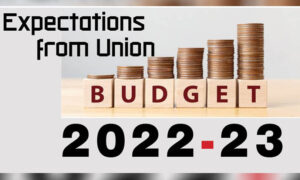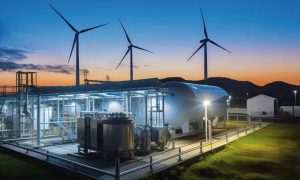Emphasis on technology and digitalization with due consideration to upskilling youth; HVACR Industry welcomes growth oriented provisions in Budget 2022.
The change is happening. The indigenization of components and ongoing trends in everything from sustainability to home ownership are moving in a positive direction. However, the skills gap continues to widen as new technology comes to market. Considering the receding pandemic issue, industry needs to continue to focus on how IAQ affects human health and productivity. Earlier the focus, that used to be on the HVAC equipment and the installation of it, is shifting to provide efficiency and comfort additionally, now.
The government has carved out a roadmap to boost India’s economy. Finance Minister Nirmala Sitharaman made varied announcements in the union budget that has something for every sector. Budget 2022 aims to reform the economy over the next 25 years. PLI in 14 sectors will create 60 lakh new jobs and additional production of INR 30 lakh crore in next 5 years. Sectors that stand to benefit are banking, infrastructure and manufacturing. It also includes the Sovereign Green Bonds; launch of a gateway for the National Digital Health Ecosystem and many more. The HVACR industry experts expressed their opinions on the Union Budget 2022, few of them are mentioned herein.
Ravichandran Purushothaman, President of Danfoss India commenting on the likely transformation of the Indian economy due to the Budget, remarks, “We welcome the progressive and growth-oriented budget presented by the Finance Minister Nirmala Sitharaman for 2022-23. As part of India’s new blueprint of infra growth for the ‘Amrit Kaal’, the increased capital expenditure, 35.40 percent above last year, will create more infrastructure, which will have a huge multiplier effect on the economy. With economic growth pegged at 9.2 percent, ahead of other large economies, and a sharp focus on sustainability and circular economy, India is well poised to withstand the challenges and reach closer to the $5 trillion GDP ambition.
With capital expenditure estimated at INR 10.68 lakh crore for 2022-23, the government has laid out the roadmap to boost India’s holistic growth. The Budget has also given the much-needed impetus to India’s agriculture and education sector with measures such as 2.37 lakh crore direct MSP payment to farmers, DESH stack, One Class One Channel. By promoting chemical – free natural farming, industries can now lead the way in boosting sustainable productivity and increased income of farmers. While the highlight of the budget was on the healthcare and infrastructure sector, some prudent initiatives for MSMEs and India Inc for start-ups have also been announced. The announcements related to green bonds and energy savings for commercial buildings highlights India’s commitment towards reduction of carbon emissions.
To facilitate energy management, the Government of India has promoted the adoption of the Energy Service Company business model for large commercial buildings. By enabling capacity building and energy audits, performance contracts, common measurement and verification protocols, this service helps in imbibing energy savings as a core value in industries across India. By providing major financial allocations to energy efficiency and data centres the path towards clean energy storage is clearer than ever. We hope that Budget 2022 acts as a guiding force to lead our government’s ‘India@100’ initiatives.”
Gurmeet Singh, Chairman and Managing Director, Johnson Controls-Hitachi Air Conditioning India Ltd., expressing his views on Consumer Durable Sector, remarked, “With focus on public investment and capital spending this Budget will certainly provide impetus to the economic growth amid the pandemic. However, we expected the budget to be a landmark in giving much needed relief and putting more money into the hands of the common man to speed up the recovery of consumer electronics and other promising sectors. We welcome the government ‘s move to aim for the creation of over 60 lakh new jobs by promoting the Production Linked Incentive (PLI) Scheme as India is certainly moving towards ‘Atma Nirbharta’ with the successful implementation of this scheme. The promising consumer electronics industry can potentially act as a growth aggregator for domestic manufacturing and employment generation helping our economy recover faster. If tapped in the right manner with custom product innovations and easy finances, India has all the potential to beat its global peers in consumer durables sales soon. Although the government is putting in a lot of effort to promote indigenisation of components, GST rationalisation of ACs will help the industry in tapping a largely untapped consumer base. The industry was optimistic for GST reduction in the budget to take India’s Air Conditioner market to new heights. We expect the government to consider rationalisation of tax rates on ACs and other essential consumer durable electronic items in the near future.”
Ashish Bhandari, MD & CEO, Thermax remarks, “The Union Budget is a promising one, looking to build long term growth as the economy recovers from the impact of the COVID-19 pandemic. Specifically for the energy sector, there are many positives from this Budget. The Sovereign Green Bonds is a remarkable step for funding the projects with a focus on using cleaner alternatives in every sector. This will help reduce the overall carbon footprint of the Indian economy and help achieve the renewable energy target of 175 gigawatt by the year 2022. The additional allocations of Rs. 19,500 crore to boost the manufacturing of solar modules under the government’s flagship PLI scheme will also help achieve the goal of 280 gigawatt of installed solar capacity by 2030.”
Manish Chourasia, Managing Director, Tata Cleantech Capital Limited remarked, “The announcement of the Finance Minister to issue sovereign green bonds to mobilise resources required for green infrastructure will certainly help boost the financing of clean energy projects, thereby providing an impetus to the Indian energy sector. With the Approved Module Manufacturer List becoming applicable from April 2022, the allocation of an additional INR 19,500 crore under PLI scheme for solar would help create a much needed manufacturing ecosystem. The enhanced focus on electric mobility is showcasing the clear desire to mainstream this emerging industry. Overall, the budget is giving clear direction for India to meet its COP26 commitments by 2030.”
N. Venu, MD & CEO, India & South Asia, Hitachi Energy says,“India delivered a pro-growth budget with a significant push to capital expenditure to boost the supply side and attract private investment. The government appears to have had its ears to the ground and covered a vast gamut of sectors in its four priority areas – PM Gati Shakti, Inclusive Development, Climate Action, and Energy Transition. Intentions have been clear – steer India toward sustainable development with a strong focus on financial support to MSMEs and expansion of emerging sectors such as solar power, EV infrastructure, railways, data centres.
Additional allocation of INR 19500 crore for PLI scheme, development of new-gen trains over the next three years, INR 1400 cr allocation for hydro and solar projects in FY23, rationalisation of custom duties on select capital goods, wider coverage of single-window clearance for green projects will pave the way toward clean energy transition. Clear emphasis on technology and digitalization with due consideration to upskilling the youth and R & D to build back better are a big positive. While some important elements such as a new SEZ legislation, funding schemes for new metro rail systems and cleantech, urban planning to promote sustainable living, battery swapping policy appear to work in progress. The government has laid the blueprint for growth over the coming two-three decades.
Unambiguous intent on achieving its COP26 ambitions through key proposals such as urban planning, energy efficiency, increased budget for PLI, distributed grids for remote villages, and finance to enable these through new climate finance services and categorising grid-scale BESS as harmonised infra. Focus on standardised and efficient mass transport metro & rail will help normalise costs. The battery swapping and interoperability proposals for EVs are a way of triggering adoption, which will then create enough demand for technology evolution. MSME ratings will help calibrate the Indian supply chain to world-class.
George Rajkumar, Country President, Grundfos India is of the opinion, “Budget 2022 has laid the foundation for India@100 with the Government showing its commitment towards a sustainable and a greener future for Indians. With India expected to grow at 9.27 percent, the much needed impetus towards climate action has been observed in this year’s budget. The allocation of INR 60,000 crores towards the ‘Har Ghar Nal Se Jal’ initiative to connect 3.8 crore households with tap water connection is commendable and will also boost the country’s water infrastructure. While nearly half of our population is residing in urban areas, the focus on sustainable measures for megacities must also include sustainable management of water and wastewater to prevent loss of water, improve recycling and also reduce destruction from natural calamities such as floods and droughts. The roadmap of transitioning towards a circular economy across sectors is also a welcoming move and will have a direct impact on our fight against climate change. The introduction of sovereign green bonds for funding of green infrastructure and the energy audit mechanisms for large commercial buildings will be a game-changer for infrastructure projects, enabling further carbon reduction while we grow our economy by leaps and bounds.”
Gaurav kumar, partner, MG Cooling Solutions expressing his thoughts says, “Union Budget 2022 brings a sense of optimism and reflects the continued focus to boost on ‘Make in India’, reducing the dependency on imports. Duty concessions to promote electronic manufacturing will help the industry to sustain itself while recuperating from the challenges of the Covid-19 pandemic. The Finance Minister’s commitment to establishing a strong 5G ecosystem will lead to product inventions across several categories including appliances that will be IoT enabled which opened the pathways to smarter and energy efficient HVAC technologies in India. The budget is concentrated on invention and entrepreneurship and that is the current need. As new entrepreneurship will come into view with the government’s provocation, new job opportunities will be created and the economy will get a boost.
Cookie Consent
We use cookies to personalize your experience. By continuing to visit this website you agree to our Terms & Conditions, Privacy Policy and Cookie Policy.















